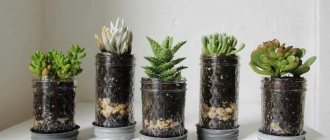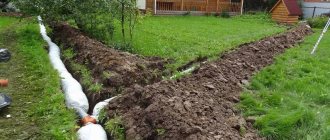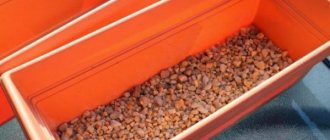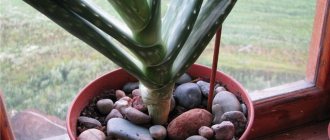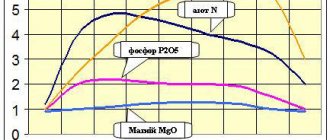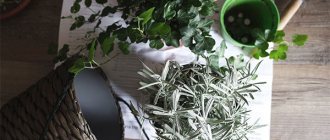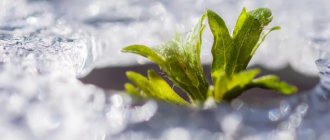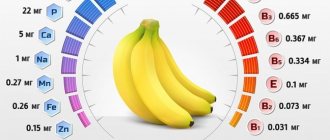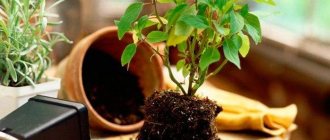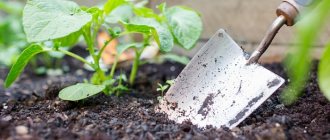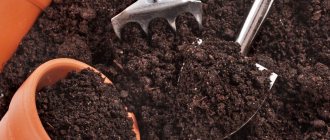Expanded clay is pellets. They can be round or cylindrical. The material is obtained by processing clay at a high temperature of 1200 0C. Depending on the size and shape of the pellets, expanded clay gravel, crushed stone and sand are distinguished. The main area of application is construction.
The material is used for the production of slabs and porcelain stoneware. It is used as a filler to insulate foundations and floor coverings. Expanded clay is actively used for growing plants. What characteristics attracted plant growers? How to work with this material?
Drainage and its purpose
Many houseplants require a soil composition that provides approximately 50% solids, 35% water and 15% air. Only a properly laid drainage layer will help recreate optimal conditions for growth and flowering.
The problem with lack of drainage is that overwatering displaces air, which is vital for flowers. The lack of oxygen in the soil provokes the development of pathogenic bacteria. The root system begins to rot and the plant withers. The drainage layer ensures the outflow of excess moisture and good breathability.
Indoor plants and drainage in pots
Main characteristics
Expanded clay pellets are porous. They have a lot of air. The material is introduced to maintain the soil in a soft state. Both gravel and crushed stone are used. Expanded clay supports normal gas exchange processes for plants.
It is used both in garden beds and for preparing soil mixtures for seedlings and for growing indoor flowers.
The pores of crushed stone can fill with water. The material is hygroscopic. Water is retained in the pores for a long time. Expanded clay releases moisture to plants gradually, maintaining a constant water balance in the soil. This is especially important for moisture-loving flowers and garden crops.
The numerous pores found in the pellets make crushed stone a good material for insulation. It maintains a constant soil temperature. Expanded clay is introduced into the holes for planting seedlings. Plants are covered with it to protect them from low temperatures. This is especially true in spring and autumn, when preparing seedlings for the winter.
The material is dusty. It must be washed before use. Expanded clay is characterized by an increased pH. For some plants, such as strawberries, cucumbers, tomatoes, this is normal. For many flowers and garden crops, it is necessary to normalize the substrate in terms of acidity.
What can be used as drainage
To lay drainage, you can use materials such as gravel, expanded clay, crushed stone, broken brick, peat, charcoal, river sand, polystyrene foam or any synthetics. An important quality of the drainage layer for indoor plants is good moisture permeability, inertness to chemicals, resistance to rotting and mold.
Drainage has different fractions, which are selected depending on the flower.
Expanded clay for flowers
A material with a porous structure, expanded clay, is baked clay. It is used in construction as an effective sound insulator and insulation. In floriculture, fine- and medium-fraction expanded clay is used. The main advantages are lightness and ability to absorb water. When the earthen ball dries out, the material releases moisture back into the soil.
Expanded clay is a chemically neutral, odorless material. It can be used several times. After about 6 years it crumbles into the ground. For drainage of large indoor plants, medium-fraction expanded clay (diameter 2 cm) is suitable. It is important that the size of the hole at the bottom of the pot is smaller than the fraction of the material. The optimal height of the drainage layer is 2 cm. If you are using a container without holes, then the expanded clay layer should be 5 cm. Sprinkle sand on top.
Layer of expanded clay in a pot
Ceramic shards
Pieces of ceramics will serve as a good drainage material for indoor flowers. Place several small shards or large pieces with the convex side up on the holes in the pot. Pour 1.5 cm of purified coarse sand on top into a small container, and 5 cm into a large container. The disadvantage of the material is the risk of damage to the roots by the sharp sides of the shards. You should not use pieces of ceramic that are too large, as sand will spill through them.
Ceramic shards
Perlite and vermiculite
The material vermiculite is produced by heating clay to high temperatures. As a result of heat treatment, minerals are pressed together, forming flakes. In appearance, vermiculite resembles wood or cork shavings. It is light, inert, and does not harm indoor plants.
Perlite is elastic silica of volcanic origin. It appears as white or gray granules. Both materials are capable of absorbing moisture with mineral and organic substances. They return water back to the soil as needed. The disadvantage of this type of drainage is its high cost.
Perlite and vermiculite
Sphagnum moss
Many gardeners use pure sphagnum moss as a drainage material. This natural drainage holds water well and releases it to dry soil. In addition, it has disinfecting properties. Moss grows on moist, swampy forest soils. It consists of soft stalks of light green light, from which the same soft needle-like leaves grow to the sides.
Sphagnum moss can be harvested in any season, but it is preferable to do it in the fall: this way it will better retain moisture during transportation. Before laying the drainage, the moss is filled with warm water (temperature about 45 degrees). This procedure saturates the material with moisture and gets rid of possible insects.
Store moss in the refrigerator or freezer. The material is first placed in a plastic bag, but not tightly closed to allow air access. It is important to note that when defrosted, moss does not lose its beneficial qualities. The only disadvantage of the material is its inaccessibility. It is not always available in flower shops, and getting to the forest for it is not always possible.
Sphagnum moss
Charcoal
Charcoal drains the soil well for indoor plants. It functions as a natural fertilizer and antiseptic. Charcoal prevents putrefactive processes, adsorbs salts, and regulates soil moisture saturation. Charcoal drainage also absorbs and retains water and minerals well.
Charcoal is a neutral, inert, lightweight and porous material. For drainage, it is laid out on the bottom of the planting container in a two-centimeter layer. It is advisable to take large fractions or such that they do not pass through the holes of the pot.
Charcoal drainage in a pot
Crushed stone and gravel
Good drainage for flowers is obtained from medium-sized fractions of crushed stone and gravel. These materials are perfect for small pots with indoor plants that are rarely replanted and moved from place to place. The main disadvantage of crushed stone and gravel is their heavy weight.
Gravel for turf
Broken brick
Broken clay brick is another option for good drainage for flowers. During production, various additives are added to the clay to improve its quality, and then fired. As a result, the natural material is strong and absorbs moisture well.
The main disadvantage is the sharp edges of broken bricks, which can damage the roots of a houseplant. It is better to sharpen the pieces a little before storing them. Instead of red ceramic brick, you can use silicate brick. It has more pronounced drainage properties.
Broken brick
Foam drainage
Foam can be used as a drainage layer. In every home there is at least one box of household appliances containing this material. Polystyrene foam is lightweight, does not absorb water, does not decompose, does not deform, is non-toxic, and has no odor. It is good to use in heavy ceramic flowerpots.
Excess moisture flows down the foam into the tray. To lay drainage, the material is cut into cubes and placed on the bottom in a layer of 2 cm. The disadvantage of polystyrene foam is that over time, the roots of indoor plants entwine the material. In view of this, when replanting there is a danger of damaging the root system.
Polystyrene foam as drainage
Sea or aquarium stone
An alternative to crushed stone and gravel is small sea or aquarium stone. It is great not only as a drainage layer in a pot, but also for decorating the soil of a houseplant. The only thing that can discourage a gardener from purchasing such drainage is the high price.
Sea stones as drainage for a flower
Application of expanded clay
Bottom drainage
The material will protect the roots from stagnation of moisture, absorb excess and slowly release it into the external environment. This has a particularly positive effect on the condition of moisture-loving plants that require frequent watering: the soil will not become sour, and in the intervals between the supply of moisture (without extreme intervals) the flower will not suffer from drought.
The recommended thickness of the lower expanded clay drainage is from 2 cm, depending on the depth of the pot.
Upper drainage
By accumulating water, the granules prevent its rapid evaporation from the surface of the substrate. If there is no one to entrust with watering the flowers during a short-term vacation, the upper drainage made of expanded clay will help the moisture stay in the ground longer. However, with regular heavy watering, it is better to abandon this idea - the soil may turn sour.
Salts contained in tap water often settle on the surface of the substrate - alkalization of the soil occurs. For this reason, it is recommended to periodically change the top layer of soil for indoor plants. However, when using expanded clay, salts accumulate on the shell of the granules - it is easier to replace them.
Another advantage is protection against overheating in hot weather. Breathable expanded clay heats up in the sun more slowly than the ground.
The recommended thickness of the upper drainage made of expanded clay is at least 1 cm.
As part of the earth mixture
Fine-fraction expanded clay is often used as a loosening agent for heavy soils. It promotes better air exchange and increases the hygroscopicity of the substrate, protecting the roots from rotting in case of excessive watering. Manufacturers often include expanded clay in the substrate for cacti and other succulents. Collectors have not made such a decision, but it has its own logic: expanded clay is covered with a hard ceramic shell - it will easily absorb a small excess of moisture, but will release it less actively.
Hydroponics
When growing without a substrate, the main task is to provide the optimal amount of nutrients to the root system. Expanded clay is used as a medium that conducts water and fertilizers dissolved in it to the roots. It does not rot, does not mold, and performs well in intermittent flooding systems, in systems with frequent watering cycles, and even with the pump constantly on. Properly prepared expanded clay is chemically neutral to the ions of the nutrient solution and is suitable for reuse.
Why are drainage holes needed in a flower pot?
In addition to proper drainage, it is important to find a good pot for planting. When purchasing a container, pay attention to whether it has drainage holes, what size they are and how they are located. If the holes are too small, the moisture will drain slowly, if they are large, the moisture will drain quickly. If there are no holes at all, they can be made at home using a drill with a suitable drill diameter.
To ensure the correct soil moisture for certain indoor plants, you should choose a container with the correct holes:
- For succulents, cacti and some types of orchids, moisture must drain quickly. A small pot with porous soil and small holes is suitable for them.
- For plants growing in high humidity, it is better to select containers with dense soil and a minimum of small holes.
Drainage holes in flower pots
Beautiful examples
The use of expanded clay is a quick and inexpensive way to decorate a site. Several photographic examples will allow you to verify this.
The video below shows an example of using colored expanded clay when decorating a flower bed.
Source
How to make a drainage layer
When the drainage material and planting container are prepared, you should proceed to installation. Step-by-step instructions on how to make drainage in a flower pot at home:
- Before starting work, make sure that all tools are clean and disinfected. Containers for planting must be dry.
- Before installation, carefully read the instructions for the drainage material; some of them require pre-soaking.
- Be sure to replace the drainage material with a new one when planting, transplanting, including during emergency procedures. If crushed stone or expanded clay is used, they should be washed, disinfected, dried, and then reused (maximum service life is 6 years).
- Select the layer height depending on the requirements of a particular plant. If the care recommendations do not indicate what kind of drainage is needed, then use low or medium. The usual drainage layer is 1–3 cm, medium – 4–5 cm, high – more than 5 cm.
- Adjust drainage height based on the number and diameter of drainage holes if necessary. If there is 1 large hole in the pot, then increase the minimum layer to 3 cm. For small holes, only high drainage is suitable. If there are many holes and they are large, then limit yourself to a layer 1 cm high.
- It is important that the drainage material lies evenly. To do this, tap the pot on the sides or shake it a little. If you are using shallow drainage, add a thin layer of soil on top. For coarse drainage material, add coarse sand.
- Completely cover the drainage layer and level the soil or sand. After this, proceed to transshipment or planting of a house plant.
Drainage layer
Additional tips, recommendations
House flowers, like the gardener himself, do not always care what kind of drainage you use. Therefore, when choosing it, you need to be guided by both your preferences and the needs of the plants. In this regard, you should heed the following recommendations:
- If accessibility is the main thing for you, then give preference to foam, cork, ceramic shards or brick (whatever comes to hand). You can even use old aquarium rocks or walnut shells.
- If drainage qualities, safety and accessibility are equally important, then it is better to choose expanded clay, crushed stone or gravel.
- If the flower is prone to root rot (or you often overwater the soil), then choose charcoal or sphagnum.
- If you don’t like unnecessary steps (crushing material, disinfecting), buy perlite or vermiculite.
- If the above-ground part of the plant is very massive and the root system is shallow, then heavy drainage will help give stability to the pot. In this case, crushed stone or gravel will do.
Whatever material you choose to construct the drainage layer, it should be quite large. The diameter of individual pebbles should be about 2 cm. Larger sizes are acceptable if for some reason you planted the flower in a pot without drainage holes. In any case, you must make sure that all stones are free of sharp corners and edges. Otherwise, they need to be sharpened to prevent damage to the roots.
Source: rastenia.info
Errors in the manufacture of drainage
Flower growers often make mistakes when making drainage:
- Do not use fine sand, which will clog the water drainage holes over time.
- You should not use large fractions, which do not retain moisture at all, and it immediately flows into the pan.
- Do not use natural materials that tend to rot, such as sawdust or tree bark. The rotting process often provokes plant diseases.
- It is not advisable to use marble chips. This material, when interacting with water, changes the acidity of the soil.
- It is not recommended to use materials with sharp edges: they can damage the root system of the plant.
How to replace expanded clay?
For drainage, you can take stones (pebbles, crushed stone, gravel), coconut fiber and polystyrene foam. They do not accumulate moisture, but also do not affect the pH of the soil. Crushed brick and clay shards, like expanded clay, have an alkaline reaction, which should be taken into account when preparing a soil mixture for the needs of a particular plant. Pine bark is sometimes used, but it is less durable. If the goal is to prevent rapid evaporation of moisture, sphagnum moss can be used as top drainage.
Coarse sand, coconut fiber or foam chips are suitable as a substrate loosening agent If you need a material with moisture-storing capacity, pay attention to perlite and vermiculite - they have greater moisture capacity than expanded clay and have a pH value close to neutral.
Forum of flower growers Frau Flora
About growing indoor and garden plants; discussion of species, varieties, diseases, pests.
Moderator: Floriana
Post by Yuryevna » Jan 30, 2022, 12:14 pm
Pelargonium 'Santa Maria Centennial' now looks like this after pruning on December 3, 2017. From mid-January it winters in the north-west. windowsill.
Expanded clay
Post by Florian » Jan 30, 2022, 12:34 pm
Expanded clay
Post by Yuryevna » Jan 31, 2022, 01:14 pm
Expanded clay
Post by Florian » 31 Jan 2022, 14:29
Expanded clay
Post by Lyaksandrovna » 06 Feb 2022, 23:48
Expanded clay
Post by Valery » 07 Feb 2022, 15:03
Expanded clay
Post by Lyaksandrovna » 07 Feb 2022, 23:14
Expanded clay
Post by Florian » 08 Feb 2022, 11:15
Expanded clay
Post by Lyaksandrovna » 08 Feb 2022, 22:31
Expanded clay
Post by Florian » 08 Feb 2022, 23:07
For indoor plants
Home growers use expanded clay of fine or medium fraction. Rooting of cuttings is carried out on it. Orchids, palm plants, roses, and moisture-loving flowers develop well on the substrate. The substrate must be prepared.
To grow roots, you don’t need a lot of expanded clay, so you shouldn’t take large containers so as not to over-moisten the plant. Watering is rare, bottom. With overhead watering, the pellets can rise, disrupting the development of plants.
Many plant growers are discussing the question of what can replace expanded clay. Gravel is often mixed with vermiculite or perlite. These are also substrates of natural origin. Expanded or agroperlite and vermiculite are used in plant growing. They have similar characteristics.
Expanded clay is a derivative of clay. This is an environmentally friendly material that has unique characteristics. In plant growing, it is used for soil improvement, for drainage, mulch, and rooting of seedlings. When growing garden crops and flowers in hydroponics, gravel is considered as an independent substrate.
Source
